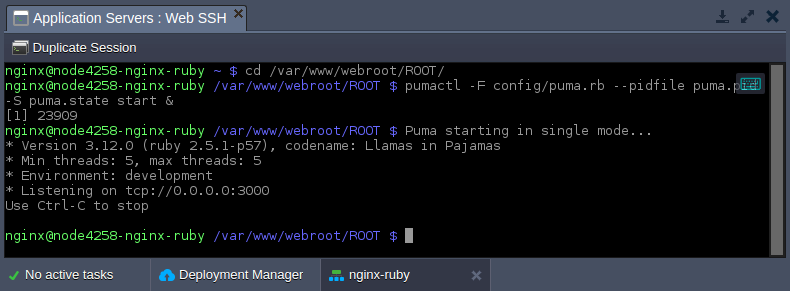Ruby Application Server Configuration
The platform provides Ruby application servers based on the two software stacks:
- Apache Ruby
- NGINX Ruby
Herewith, both ones are configured to utilize the Passenger application server by default, which is integrated via the appropriate custom module. Moreover, if needed, the NGINX Ruby stack can be easily configured to work with the different inbuilt servers:
- Passenger - one of the most feature rich application servers for Ruby, which are invaluable for the modern web apps and microservice APIs
- Puma - a Ruby web server oriented on speed and parallelism due to fast and accurate HTTP 1.1 protocol parsing
- Unicorn - an HTTP server, which takes advantage of the Unix/Unix-like kernels features for serving fast clients on low-latency, high-bandwidth connections
Let’s see how it can be switched on the NGINX Ruby server.
NGINX Application Server Modules
The Passenger module is used for all newly created Ruby environments by default. Follow the next steps to change to the different one:
1. Click the Config button next to your NGINX Ruby application server.

2. Within the opened configuration file manager panel, navigate to the /etc/nginx/nginx.conf file. Find the include app_servers strings:
- include app_servers/nginx-unicorn.conf
- include app_servers/nginx-puma.conf
- include app_servers/nginx-passenger.conf

3. Uncomment the string with the required module and comment the previously active one.
 For example, we’ll switch to Puma.
For example, we’ll switch to Puma.4. Save the changes and Restart Nodes of the NGINX application server to apply them.

5. Access your node via SSH (e.g. using Web SHH) and run the selected module with the appropriate command executed from the project directory:
| |

Note: If you would like to switch to the different module, it could be done in the same way, but you need to stop the currently running application server:
- for Puma: pumactl -F config/puma.rb –pidfile puma.pid -S puma.state stop
- for Unicorn: ps aux | grep ‘unicorn’ | awk ‘{print $2}’ | xargs kill -QUIT